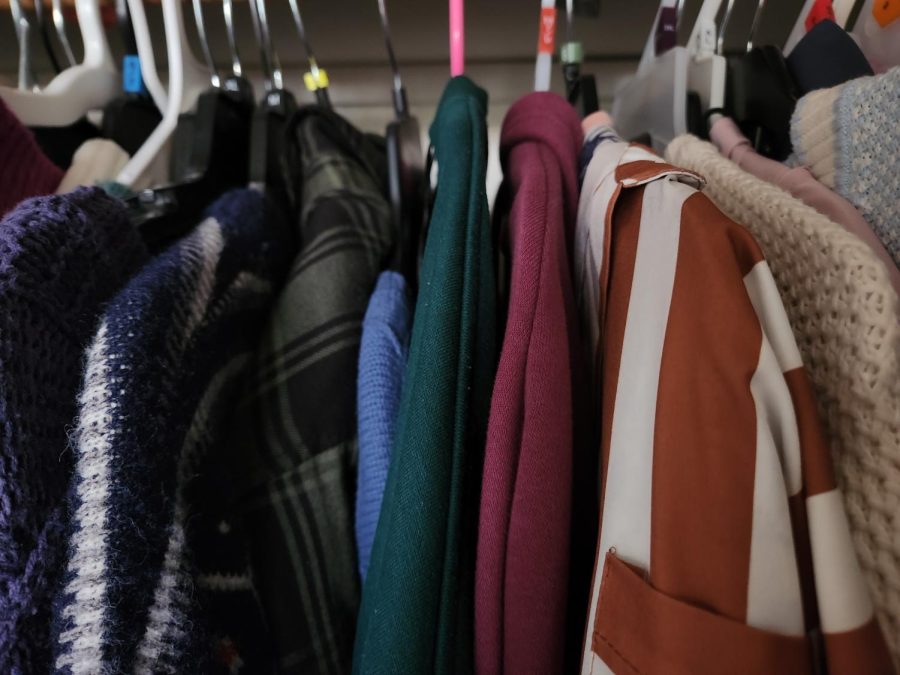Slowing Down the Speeding Fashion Industry
April 17, 2023
Scrolling through the fashion centric part of social media, one might encounter numerous “haul” videos. In such posts, individuals purchase a sizable amount of clothing and then proceed to film themselves unveiling the merchandise. Trends like these have normalized overconsumption of clothing, prompting companies to increase production of their goods. As consumers quickly cycle piece after piece, many of this overproduced merchandise ends up rotting in landfills, contributing to the worsening global climate disaster.
Combating this wave of impractical consumerism, a new movement of environmentally conscious fashion has risen to spread awareness on the damaging effects of fast fashion. As the media becomes more environmentally conscious of the impacts of the speeding fashion industry, thrifting has had a rise in popularity, resurfacing as a sustainable alternative to fast fashion.
One of the biggest appeals of thrifting is the budget friendly price tag. Thrift stores offer a wide variety of clothing at affordable prices, benefiting many lower income families in need of necessities.
“I started thrifting as a means to save money,” explained college freshman, Carolina Ortiz, “My family immigrated from Mexico and thrifting was a way for us to get nice clothes for cheap.” Eventually Ortiz found herself becoming very passionate about the benefits of thrifting and sustainable fashion.
Ortiz is not alone, according to a Sales Report by ThredUP, approximately 2 out of 5 items in Gen Z’s closet’s are secondhand. At an age where many are exploring their identity and self expression, having a personal style is often vital. However, most teens don’t have much of an income to spend on clothes that fit their taste. Thrifting allows them to shop within a lower budget while also exploring their style with the unique pieces a thrift store has to offer.
In addition, sending used clothes off to thrift stores instead of throwing them away keeps them in circulation and out of landfills. The fashion industry produces 92 million tons of textile waste every year. Since fast fashion utilizes quantity over quality, durability of products is often sacrificed in order to mass produce clothing. Consequently, consumers are quick to dispose of these garments.
“Shopping second hand helps me avoid purchasing low grade clothing that becomes unwearable after a couple of washes and has to be thrown out,” said Hinsdale South senior, Claire Petrosius. Donating clothes to thrift stores helps extend the life of existing clothes, reducing the need for new ones. It also can help lessen the demand for new products, prompting companies to lessen their destructive mass production.
For most people, stopping global climate change is no feasible task. With mass corporations being largely responsible for the issue at hand, any efforts at sustainability by common people may seem to be outweighed. However, knowing that most companies won’t stop their streaks of havoc, a change in our society and climate is ultimately up to consumers. Although actions such as thrifting won’t solve climate change, they are a step towards a more sustainable world.
However, as thrifting has become more popular, it has deviated from its typical demographic. Although thrifting is made to benefit lower income people and families, it has developed its own niche market among collectors with carefully curated shops, marking up vintage clothing by hundreds of dollars.By buying up large quantities of affordable clothing and reselling them for much more than they are worth, resellers risk increasing prices, putting a strain on families in need of affordable options.
Furthermore, thrifting should not be the end goal of sustainability. Merely shopping second hand is not the only aspect of sustainable fashion. “A lot of times, people forget that sustainable fashion isn’t just about where you get your clothes,” clarified Ortiz, “It’s also about changing your perspective on how your own consumption impacts the environment.”
By consuming responsibly through buying needed clothes, rewearing already owned clothes, and supporting small sustainable fashion brands we can move towards a more eco-conscious mindset that better supports our climate.






